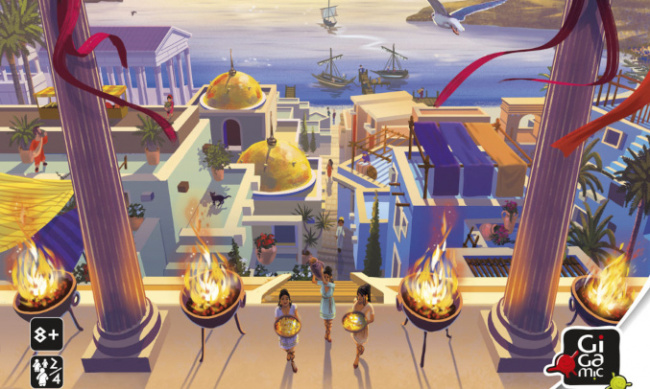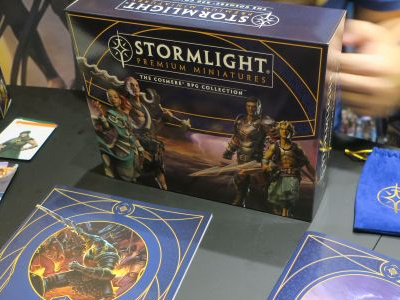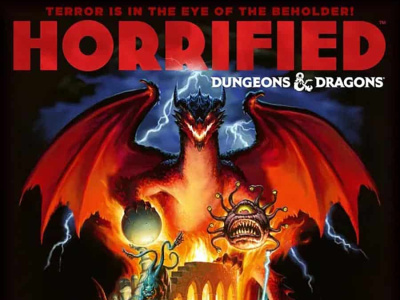Akropolis
Publisher: Gigamic (Hachette Boardgames)
Release Date: September 6, 2022
MSRP: $29.99
Creator(s): Jules Messau and Pauline Détraz
Format: Boxed, Game tiles
Number of Players: 2-4
Playing Time: 25 mins.
Product #: GAKR-EN
Age Rating: 8+
ICv2 Rating: 4.5 Stars out of 5
This is one of those games that could be considered a filler, to be played between more serious games, or as a light-to-medium game for less serious gamers. Either one is slightly inaccurate, and a bit unfair to the game. Instead, this is a game which could be played as either, or as a serious tactical game that happens to have simple rules and short playing time.
Akropolis is a very good game whose rules are simple, but the fun of the game comes from learning the tactical use of the tiles to get the best score. Since the tiles are given to players in an ongoing form of drafting, with varying costs and a tight economy, this becomes more and more interesting as the game progresses. While the game length is actually a bit more than the optimistic suggestion on the box, the playing time is still well under an hour even for beginners, and the rule book is very clear. The setup and scoring each take a few minutes at most, because the setup consists of making stacks of tiles, based on the number of players, and the scoring consists of a few very simple bits of arithmetic per player. Everything that needs to be scored is visible at the end of the game, so checking scores is also easy.
Each player starts with an identical starting tile, and starting with the first player, chooses one tile from a short row of tiles, the length of which depends on the number of players. The first player gets the least units of stone at the start, and stone is the only commodity in the game used to purchase tiles out of order in the row. Often, the tile a player really wants is not first in the row, so having a little stone on hand becomes very useful.
Each tile has three sections, made up of two kinds of areas, and there are several different colors, each representing a different kind of area. Each player is using these to build a city of sorts, and you can build a second or third level to your city, once you learn to plan your layout. The difficulty is that the only way to get more stone is to build on top of stone quarry areas, but anything else that you build over no longer counts to your benefit. Each new tile has three hexagonal areas on it, so building upward is three hexes at a time. Learning to arrange for these three to all be quarries is tricky at first, and sometimes not possible, so players will almost always face the question of what else to give up. Each area has different scoring rules, which may confuse new players at first, but these are very clearly explained in the rulebook. Since the plaza areas have a star symbol on them, it’s easy to tell them from the regular districts of the same color. Scoring is based on multiplying the number of regular districts of a color [extra points if they’re on a higher level] by the number of stars on your plazas of that color. That means if you have no blue plazas, it doesn’t matter how many blue districts you have, because they will be multiplied by zero, since you have zero blue stars. So, the game is about balancing your need for districts to earn points and plazas to make them score.
In a four-player game, each player will have fifteen turns. It is similar with lower player counts, but this is why the game is short. Even a bout of analysis paralysis can’t slow the game by much, because every possible tile can be played, no matter what you’ve done previously. It often can be played in a way that does not help you very much, which is where the tactics come in.
Because the designs on the tiles are different, even people with limited color vision should be able to play the game. For instance, both red and green are used as colors, but red represents military barracks and green represents parks, and the graphics are very different.
While the game suggests an age range of eight and up, some younger players will find it frustrating. Kids who have experience with games will have no problem with it, but it is clearly a game that teens and adults will enjoy as well, so it could be played by families.
--Nick Smith: Library Technician, Community Services, for the Pasadena Public Library in California.

ICv2 Stars: 4.5 (Out of 5)
Posted by Nick Smith on September 26, 2022 @ 3:00 am CT
MORE GAMES
In 'Dracula vs. Hitler'; New RPG Just Unveiled by Devir Games
August 1, 2025
Devir Games unveiled Dracula vs. Hitler , a new RPG, that will be heading to BackerKit.
For 'Cosmere RPG'
August 1, 2025
Brotherwise Games previewed their Stormlight Premium Miniatures Collection , for Cosmere RPG .
MORE REVIEWS
ICv2 Stars: 3.5 (out of 5)
July 30, 2025
Here is a review of Ravensburger's Horrified: Dungeons & Dragons.
ICv2 Stars: 3.5 (out of 5)
July 24, 2025
Check out the review of Disney Villainous: Treacherous Tides, from Ravensburger.








